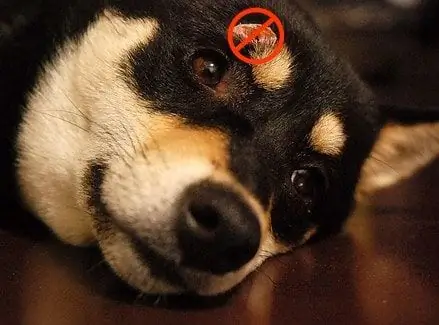
- Autore Daisy Haig [email protected].
- Public 2023-12-17 03:10.
- Ultima modifica 2025-01-24 12:38.
Entrambi i miei bulldog francesi hanno sofferto di tumori sgradevoli, spesso pruriginosi e tecnicamente benigni che chiamiamo istiocitomi. Sebbene gli istiocitomi si risolvano in genere dopo due o tre mesi, l'incertezza sulla provenienza di questo tumore porta la maggior parte dei veterinari a tagliarlo (o almeno parte di esso) per garantirne la benignità.
Un bisturi chirurgico di una massa "benigna" può sembrare estremo per te, ma poiché gli istiocitomi possono essere sia fastidiosi che spaventosi, la chirurgia è spesso indicata.
Fastidioso: perché si presentano spesso sulla testa e sui piedi, punti in cui una massa perfettamente rotonda e ulcerata può essere facilmente graffiata o leccata.
Spaventoso: perché è difficile dire se ciò che è appena spuntato sulla pelle del tuo cane (e di solito succede velocemente) è un brutto tumore dei mastociti (o qualche altra massa mostruosa)… o il suo cugino più facile, il istiocitoma.
Spaventoso: perché è difficile dire se ciò che è appena spuntato sulla pelle del tuo cane (e di solito succede velocemente) è un brutto tumore dei mastociti (o qualche altra massa mostruosa)… o il suo cugino più facile, il istiocitoma.
while young dogs (under three years of age) are more likely to get these, they can happen to dogs of any age. indeed, my older frenchie, sophie sue got one about a year ago. she was nine-not exactly a spring chicken. vincent has had three. and he’s not yet two years old.
some breeds are more predisposed. labrador retrievers and boxers, for example. though frenchies aren’t on the list, perhaps they should be… (perhaps they should be on the list for almost everything if my recent round of healthcare scares is any guide.)
ugly and prominently placed as they typically are, most owners want histiocytomas removed. some vets, however, will counsel owners to either wait a few weeks (especially if the dog is young and statistically less likely to be suffering from a malignant mass) or to have a simple section of it snipped (with a local anesthetic) for histopathological analysis at the pathology lab.
other vets will even take a needle poke at it, though most pathologists find that histiocytomas are not easily disgnosed definitively through this method (cytology).
if the dog is older or the mass is especially annoying to the dog or owner, however, we remove the whole sucker and clean up the mess quickly. unfortunately, though, this approach is more costly and usually requires general anesthesia. it’s nonetheless the approach i take for more than half of these tumors…better to be safe than sorry, right?
still, most owners need to know they have a choice. the nervous nellies among you (like me) are less likely to want to stare at a mass for a couple of months to see if it simply goes away. the rational or more anesthetically cautious, however, are justified in waiting-as long as their dog is young and/or hasn’t suffered from malignant masses in the past.
whatever choice you make, consider histiocytomas an excellent foray into the world of skin tumors. it’s like a warm-up for what’s likely to come as your dog ages. and it’s not all bad. look on the bright side: curing cancer is sometimes just a scalpel slice away.
Consigliato:
Non è Una Sorpresa Che I Proprietari Di Animali Domestici Spendano Così Tanto Ogni Mese Per I Loro Familiari Non Umani

Scopri quanto spendono i genitori di animali domestici ogni mese per i loro animali
Friendly Skies' Non è Così Amichevole Per Gli Animali Domestici

La gente sembra volare per meno soldi che mai in questi giorni. E anche se ti potrebbe essere addebitato un supplemento per uno spuntino, una bevanda o il controllo dei bagagli sul tuo volo (sono state fatte discussioni anche sull'addebito per l'utilizzo dei servizi igienici), almeno è possibile fare una fuga veloce a buon mercato
Affettare, Tagliare A Cubetti E Biopsiare L'istiocitoma Benigno

Due dei miei ultimi quattro cani hanno sofferto di tumori della pelle sgradevoli e tecnicamente benigni che chiamiamo istiocitomi. Sebbene gli istiocitomi in genere si risolvano dopo due o tre mesi (o meno), l'incertezza sulla provenienza di questo tumore porta la maggior parte dei veterinari a tagliarlo via (o almeno parte di esso) in modo che tutti possano dormire sonni tranquilli la notte senza che il male si nasconda non trattato
Tumore Della Pelle (istiocitoma) Nei Cani

Un istiocitoma è un tumore cutaneo benigno che ha origine nelle cellule di Langerhans, cellule immunitarie che funzionano per fornire immunità protettiva ai tessuti che sono in contatto con l'ambiente esterno
Tumore Della Pelle (istiocitoma) Nei Gatti

Le cellule di Langerhans sono cellule immunitarie che funzionano per fornire immunità protettiva ai tessuti che sono in contatto con l'ambiente esterno: naso, stomaco, intestino e polmoni, ma principalmente la superficie della pelle. Queste cellule sono anche chiamate cellule dendritiche e istiociti. Un istiocitoma è un tumore cutaneo benigno che ha origine nelle cellule di Langerhans
